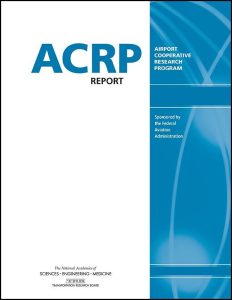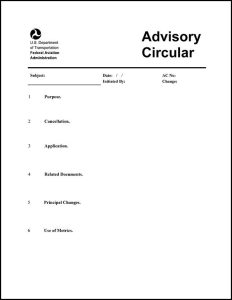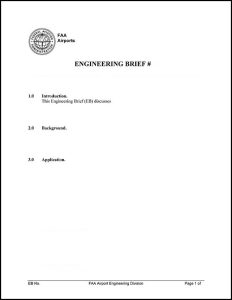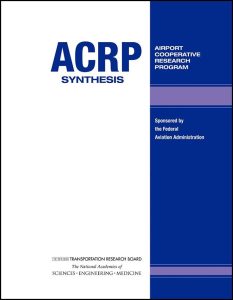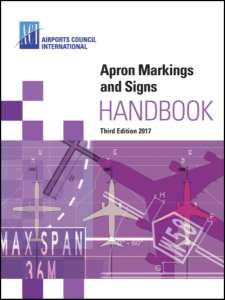To narrow the library of airside resources, use the filter boxes or airport map below or search box above.
Click an item below to expand.
Resources Matching Your Search
2010
ACRP Report 38 provides a comprehensive description of the regulations, standards, evaluation criteria, and processes designed to protect the airspace surrounding airports. Aviation practitioners, local planning and zoning agencies, and developers need to understand and apply the appropriate airspace design and evaluation criteria to ensure a safe operating environment for aircraft as well as to maintain airport operational flexibility and reliability, without unduly restricting desirable building development and attendant economic growth in the surrounding community.
2019
ACRP Research Report 195 is designed to assist airport operators in developing and implementing an obstruction management program to protect the airport airspace from encroachment by tall objects. The report will help airport staff develop an obstruction management plan by understanding the regulatory environment, identifying obstructions, and developing a strategy for communication with surrounding communities that will ensure airport involvement in any development issues that could result in an obstruction around the airport. The report is supplemented by ACRP WebResource 7: Best Practices for Airport Obstruction Management Library, which provides reference documents, model documents, and presentation materials for obstruction management outreach. A methodology for creating a composite map of all applicable airspace surfaces as well as examples of interactive airspace composite surface maps for small and large airports are also provided.
2013
This advisory circular (AC) explains the importance of reporting collisions between aircraft and wildlife, more commonly referred to as wildlife strikes. It also explains recent improvements in the Federal Aviation Administration's (FAA's) Bird/Other Wildlife Strike Reporting system, how to report a wildlife strike, what happens to the wildlife strike report data, how to access the FAA National Wildlife Strike Database (NWSD), and the FAA's Feather Identification program.
2013
Engineering Brief (EB) 91 provides new information and requirements for the management of vegetation on and/or surrounding an airport. This EB provides information on the removal or topping of vegetation as well as the collection, submission, and management of the supporting data regarding vegetation.
2017
This standard outlines vital safety provisions for procedures, equipment, and installations to protect people, aircraft, and other property during the ground fuel servicing of aircraft using liquid petroleum fuels. This is a paid resource available in print for $54.50 and in PDF $58.50.
2013
ACRP Report 99 provides a step-by-step process for identifying, selecting, and implementing technologies to treat stormwater that has been affected by applied deicing materials. The report addresses the processes for identifying the various drivers for deicer treatment and for evaluating the appropriateness of various treatment technologies to meet an airport's specific needs. The report also provides recommendations for the design, operation, and maintenance of each treatment technology.
2014
ACRP Synthesis 52 presents information on habitat management to deter wildlife at airports and manage risk to aviation. It is the third of three related syntheses and completes the series on wildlife risk management at airports. ACRP Synthesis 52 builds on previous ACRP documents, including ACRP Synthesis 23, ACRP Report 32, and ACRP Synthesis 39, which address bird deterrence and harassment techniques, various wildlife hazards and control techniques, and population management methods, respectively.
2015
ACRP Synthesis 61 reviews current practices in developing and preserving public-use seaplane bases throughout the United States. The report reviews and presents information on the planning process, design considerations, permits, regulatory requirements, and facility and service needs of seaplane bases.
2015
ACRP Synthesis 63 explores airport fueling system operations at all sizes of airports. The report describes fueling standards and regulations as well as common operations and components, and it serves as a reference for a number of fueling processes and procedures. On-airport fueling systems and components are the main focus of the report.
2018
ACRP Web-Only Document 44, Volume 1, provides a comprehensive summary of all the requirements included in the 39 Grant Assurances applicable to airport sponsors, who are owners or operators of the airport that execute the grant agreements. The web-only document describes the requirements, identifies the actions that are required and those that are prohibited, identifies exceptions, describes the duration and applicability of the requirements, and discusses the potential consequences of non-compliance.
2018
ACRP Web-Only Document 44 provides supplemental information for individuals desiring a more in-depth understanding of the requirements. It may be useful when airport management, staff, or airport users are confronted with a particular issue or a set of circumstances that is not fully addressed in ACRP Research Report 184. The web-only document contains six appendices providing supplemental information on the Grant Assurance requirements, as well as resources and references.
2018
ACRP Web-Only Document 44, Volume 3, summarizes the research efforts and results of the research conducted to develop a guidebook on FAA grant assurance requirements.
2018
ACRP Web-Only Document 44, Volume 4, is a model PowerPoint presentation for sharing content with airport managers, planners, and operators.
2017
This updated version of the Apron Markings and Signs Handbook includes best practices for the application and maintenance of paint markings on aprons. The aim of the handbook is to promote the commonality of markings worldwide and the increasing acceptance and application of these practices, leading to a safer apron environment. These markings and signs supplement those provided in ICAO Annex 14, Volume I, and the ICAO Aerodrome Design Manual, Part 4 (Visual Aids). This resource is available from the ACI store for $180 for members and $1,000 for non-members.
2020
This advisory circular (AC) provides information on when to issue runway condition reports. It also provides language that addresses the impact of snow accumulation around NAVAIDs. It includes updates based on feedback received from airport operators seeking additional guidance to help improve the implementation of the takeoff and landing performance assessment initiative. These improvements relate to reporting wet runway, slippery when wet reporting procedures, unacceptable aspects of reporting Mu values to aircraft operators, using current runway in use for generating runway surface condition reports, airport operators’ abilities to use mitigations to improve runway conditions, and clarifications on using Conditions Not Monitored NOTAMs and Surface Conditions Not Reported NOTAMs.
2019
This advisory circular (AC) has two purposes. First, this AC describes the qualifications for wildlife biologists who conduct Wildlife Hazard Assessments (WHA) for airports. Second, this AC addresses the minimum wildlife hazard management curriculum for the initial and recurrent training of airport personnel who implement wildlife hazard management plans (WHMPs).
2014
This advisory circular (AC) provides the FAA-recommended guidelines for the maintenance of airport visual aid facilities. It provides system maintenance information for establishing a preventive maintenance program for airport visual aid facilities. The information provided is for the following systems: airport lighting vault and series lighting circuits, constant current regulators, runway and taxiway elevated edge lighting systems, runway and taxiway in-pavement lighting systems, runway guard lights and stop bar lights, illuminated runway and taxiway signs, rotating beacons, lighted wind cone assemblies, precision approach path indicator (PAPI) system, visual approach slope indicator (VASI), runway end identifier lights (REIL) and omni directional approach light system (ODALS), medium intensity approach light system (MALS, MALSF, MALSR), airfield lighting control and monitoring system (ALCMS), runway status lights (RWSL), obstruction lights, control systems, standby power engine generator systems.
2018
This document was developed for individuals, teams, or task forces responsible for establishing and maintaining a security management system (SeMS) at airports. It helps individuals understand SeMS, informs them of the benefits of SeMS, and helps them determine whether an airport is ready to establish an SeMS. It also provides guidance on establishing an SeMS, the governance required to establish and maintain the SeMS, and undertaking the quality assurance of the SeMS.
2019
This document is intended to be used by airport management and staff for the purpose of understanding the benefits of as well as the processes for integrating unmanned aircraft systems (UAS) into airport security programs.
2018
This document guides aviation professionals responsible for perimeter security at airports. While the primary focus of this guidance is on the technical aspects of perimeter security and systems, such as perimeter intrusion detection systems, this document also addresses important physical security methods as well as procedural and operational security measures to facilitate effective perimeter security.
